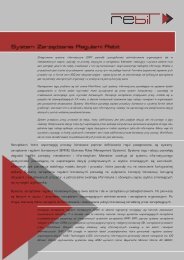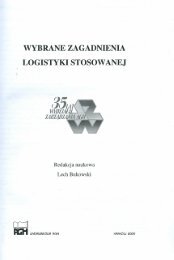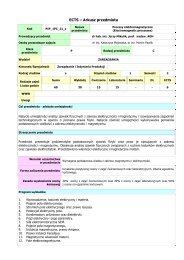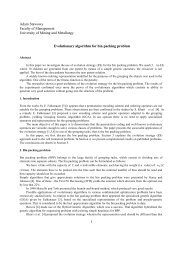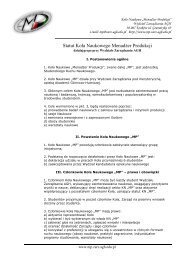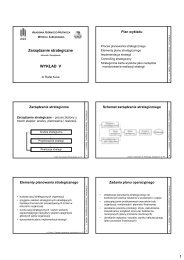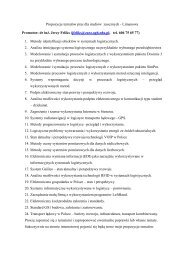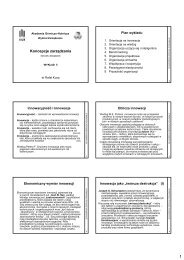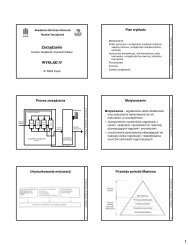Introduction to genetic algorithms with Java applets
Introduction to genetic algorithms with Java applets
Introduction to genetic algorithms with Java applets
- No tags were found...
Create successful ePaper yourself
Turn your PDF publications into a flip-book with our unique Google optimized e-Paper software.
About DNADNA (Deoxyribonucleic acid)This is a part of DNA. More pictures are available.(c) Marek Obitko, 1998http://cs.felk.cvut.cz/~xobitko/ga/dnapic.html [7.5.2000 16:33:04]
About DNADNA(Deoxyribonucleic acid)Here you can see some pictures <strong>to</strong> get an idea how the DNA looks like. Some basic information aboutbiological background is also available.http://cs.felk.cvut.cz/~xobitko/ga/dna.html (1 of 2) [7.5.2000 16:33:04]
About DNA(c) Marek Obitko, 1998http://cs.felk.cvut.cz/~xobitko/ga/dna.html (2 of 2) [7.5.2000 16:33:04]
Biological backgroundII. Biological BackgroundChromosomeAll living organisms consist of cells. In each cell there is the same set of chromosomes. Chromosomesare strings of DNA and serves as a model for the whole organism. A chromosome consist of genes,blocks of DNA. Each gene encodes a particular protein. Basically can be said, that each gene encodes atrait, for example color of eyes. Possible settings for a trait (e.g. blue, brown) are called alleles. Eachgene has its own position in the chromosome. This position is called locus.Complete set of <strong>genetic</strong> material (all chromosomes) is called genome. Particular set of genes in genomeis called genotype. The genotype is <strong>with</strong> later development after birth base for the organism'sphenotype, its physical and mental characteristics, such as eye color, intelligence etc.ReproductionDuring reproduction, first occurs recombination (or crossover). Genes from parents form in some waythe whole new chromosome. The new created offspring can then be mutated. Mutation means, that theelements of DNA are a bit changed. This changes are mainly caused by errors in copying genes fromparents.The fitness of an organism is measured by success of the organism in its life.(c) Marek Obitko, 1998http://cs.felk.cvut.cz/~xobitko/ga/biology.html [7.5.2000 16:33:05]
<strong>Introduction</strong>I. <strong>Introduction</strong>First WordsGenetic <strong>algorithms</strong> are a part of evolutionary computing, which is a rapidly growing area of artificialintelligence.As you can guess, <strong>genetic</strong> <strong>algorithms</strong> are inspired by Darwin's theory about evolution. Simply said,solution <strong>to</strong> a problem solved by <strong>genetic</strong> <strong>algorithms</strong> is evolved.His<strong>to</strong>ryIdea of evolutionary computing was introduced in the 1960s by I. Rechenberg in his work "Evolutionstrategies" (Evolutionsstrategie in original). His idea was then developed by other researchers. GeneticAlgorithms (GAs) were invented by John Holland and developed by him and his students andcolleagues. This lead <strong>to</strong> Holland's book "Adaption in Natural and Artificial Systems" published in 1975.In 1992 John Koza has used <strong>genetic</strong> algorithm <strong>to</strong> evolve programs <strong>to</strong> perform certain tasks. He called hismethod "<strong>genetic</strong> programming" (GP). LISP programs were used, because programs in this language canexpressed in the form of a "parse tree", which is the object the GA works on.(c) Marek Obitko, 1998http://cs.felk.cvut.cz/~xobitko/ga/intro.html [7.5.2000 16:33:05]
Search SpaceIII. Search SpaceSearch SpaceIf we are solving some problem, we are usually looking for some solution, which will be the best among others. The spaceof all feasible solutions (it means objects among those the desired solution is) is called search space (also state space).Each point in the search space represent one feasible solution. Each feasible solution can be "marked" by its value or fitnessfor the problem. We are looking for our solution, which is one point (or more) among feasible solutions - that is one pointin the search space.The looking for a solution is then equal <strong>to</strong> a looking for some extreme (minimum or maximum) in the search space. Thesearch space can be whole known by the time of solving a problem, but usually we know only a few points from it and weare generating other points as the process of finding solution continues.Example of a search spaceThe problem is that the search can be very complicated. One does not know where <strong>to</strong> look for the solution and where <strong>to</strong>start. There are many methods, how <strong>to</strong> find some suitable solution (ie. not necessarily the best solution), for example hillclimbing, tabu search, simulated annealing and <strong>genetic</strong> algorithm. The solution found by this methods is oftenconsidered as a good solution, because it is not often possible <strong>to</strong> prove what is the real optimum.NP-hard ProblemsExample of difficult problems, which cannot be solved int "traditional" way, are NP problems.There are many tasks for which we know fast (polynomial) <strong>algorithms</strong>. There are also some problems that are not possible<strong>to</strong> be solved algorithmicaly. For some problems was proved that they are not solvable in polynomial time.But there are many important tasks, for which it is very difficult <strong>to</strong> find a solution, but once we have it, it is easy <strong>to</strong> checkthe solution. This fact led <strong>to</strong> NP-complete problems. NP stands for nondeterministic polynomial and it means that it ispossible <strong>to</strong> "guess" the solution (by some nondeterministic algorithm) and then check it, both in polynomial time. If we hada machine that can guess, we would be able <strong>to</strong> find a solution in some reasonable time.Studying of NP-complete problems is for simplicity restricted <strong>to</strong> the problems, where the answer can be yes or no. Becausethere are tasks <strong>with</strong> complicated outputs, a class of problems called NP-hard problems has been introduced. This class isnot as limited as class of NP-complete problems.For NP-problems is characteristic that some simple algorithm <strong>to</strong> find a solution is obvious at a first sight - just trying allpossible solutions. But this algorithm is very slow (usually O(2^n)) and even for a bit bigger instances of the problems it isnot usable at all.Today nobody knows if some faster exact algorithm exists. Proving or disproving this remains as a big task for newhttp://cs.felk.cvut.cz/~xobitko/ga/searchs.html (1 of 2) [7.5.2000 16:33:05]
Search Spaceresearchers (and maybe you! :-)). Today many people think, that such an algorithm does not exist and so they are lookingfor some alternative methods - example of these methods are <strong>genetic</strong> <strong>algorithms</strong>.Examples of the NP problems are satisfiability problem, travelling salesman problem or knapsack problem. Compendiumof NP problems is available.(c) Marek Obitko, 1998http://cs.felk.cvut.cz/~xobitko/ga/searchs.html (2 of 2) [7.5.2000 16:33:05]
AboutAbout These PagesAboutThese pages were developed during August and September 1998 at Hochschule für Technik undWirtschaft Dresden (FH) (University of Applied Sciences) by Marek Obitko, student of Czech TechnicalUniversity.First versions of some <strong>applets</strong> were written during summer semester 1998 at Czech Technical University,supervised by assoc. professor Pavel Slavík. During stay in Dresden the project was supervised byprofessor Walter Pätzold from Hochschule für Technik und Wirtschaft Dresden.Pages and <strong>Java</strong> Applets were all created by Marek Obitko, (c) 1998. If you have any comments,questions or suggestions, you can send them <strong>to</strong> author.<strong>Java</strong> is trademark of Sun Microsystems, Inc.(c) Marek Obitko (obitko@email.cz), 1998http://cs.felk.cvut.cz/~xobitko/ga/about.html [7.5.2000 16:33:06]
Main pageGENETICALGORITHMSThese pages introduce some fundamentals of <strong>genetic</strong>s <strong>algorithms</strong>. Pages areintended <strong>to</strong> be used for learning about <strong>genetic</strong>s <strong>algorithms</strong> <strong>with</strong>out anyprevious knowledge from this area. Only some knowledge of computerprogramming is assumed. You can find here several interactive <strong>Java</strong> <strong>applets</strong>demonstrating work of <strong>genetic</strong> <strong>algorithms</strong>.As the area of <strong>genetic</strong>s <strong>algorithms</strong> is very wide, it is not possible <strong>to</strong> covereverything in these pages. But you should get some idea, what the <strong>genetic</strong><strong>algorithms</strong> are and what they could be useful for. Do not expect anysophisticated mathematics theories here.Now please choose next <strong>to</strong> continue or you can choose any <strong>to</strong>pic from themenu on the left side. If you do not want <strong>to</strong> read all the introducing chapters,you can skip directly <strong>to</strong> <strong>genetic</strong> <strong>algorithms</strong> and return later.You can also check recommendations for your browser.This site has also a Japanese translation.[This page <strong>with</strong>out frames] [This page <strong>with</strong> frames](c) Marek Obitko, 1998http://cs.felk.cvut.cz/~xobitko/ga/main.html [7.5.2000 16:33:06]
Genetic algorithmIV. Genetic AlgorithmBasic DescriptionGenetic <strong>algorithms</strong> are inspired by Darwin's theory about evolution. Solution <strong>to</strong> a problem solved by<strong>genetic</strong> <strong>algorithms</strong> is evolved.Algorithm is started <strong>with</strong> a set of solutions (represented by chromosomes) called population. Solutionsfrom one population are taken and used <strong>to</strong> form a new population. This is motivated by a hope, that thenew population will be better than the old one. Solutions which are selected <strong>to</strong> form new solutions(offspring) are selected according <strong>to</strong> their fitness - the more suitable they are the more chances they have<strong>to</strong> reproduce.This is repeated until some condition (for example number of populations or improvement of the bestsolution) is satisfied.ExampleAs you already know from the chapter about search space, problem solving can be oftenexpressed as looking for extreme of a function. This is exactly what the problem shown hereis. Some function is given and GA tries <strong>to</strong> find minimum of the function.You can try <strong>to</strong> run <strong>genetic</strong> algorithm at the following applet by pressing but<strong>to</strong>n Start. Graphrepresents some search space and vertical lines represent solutions (points in search space).The red line is the best solution, green lines are the other ones.But<strong>to</strong>n Start starts the algorithm, Step performs one step (i.e. forming one new generation),S<strong>to</strong>p s<strong>to</strong>ps the algorithm and Reset resets the population.Here is applet, but your browser does not support <strong>Java</strong>. If you want <strong>to</strong> see <strong>applets</strong>, please check browserrequirements.Outline of the Basic Genetic Algorithm1.2.3.[Start] Generate random population of n chromosomes (suitable solutions for the problem)[Fitness] Evaluate the fitness f(x) of each chromosome x in the population[New population] Create a new population by repeating following steps until the new populationis complete1. [Selection] Select two parent chromosomes from a population according <strong>to</strong> their fitness (thebetter fitness, the bigger chance <strong>to</strong> be selected)http://cs.felk.cvut.cz/~xobitko/ga/gaintro.html (1 of 2) [7.5.2000 16:33:06]
Genetic algorithm4.5.6.2. [Crossover] With a crossover probability cross over the parents <strong>to</strong> form a new offspring(children). If no crossover was performed, offspring is an exact copy of parents.3. [Mutation] With a mutation probability mutate new offspring at each locus (position inchromosome).4. [Accepting] Place new offspring in a new population[Replace] Use new generated population for a further run of algorithm[Test] If the end condition is satisfied, s<strong>to</strong>p, and return the best solution in current population[Loop] Go <strong>to</strong> step 2Some CommentsAs you can see, the outline of Basic GA is very general. There are many things that can be implementeddifferently in various problems.First question is how <strong>to</strong> create chromosomes, what type of encoding choose. With this is connectedcrossover and mutation, the two basic opera<strong>to</strong>rs of GA. Encoding, crossover and mutation are introducedin next chapter.Next questions is how <strong>to</strong> select parents for crossover. This can be done in many ways, but the main ideais <strong>to</strong> select the better parents (in hope that the better parents will produce better offspring). Also you maythink, that making new population only by new offspring can cause lost of the best chromosome from thelast population. This is true, so so called elitism is often used. This means, that at least one best solutionis copied <strong>with</strong>out changes <strong>to</strong> a new population, so the best solution found can survive <strong>to</strong> end of run.Some of the concerning questions will be discussed later.Maybe you are wandering, why <strong>genetic</strong> <strong>algorithms</strong> do work. It can be partially explained by SchemaTheorem (Holland), however, this theorem has been criticised in recent time. If you want <strong>to</strong> know more,check other resources.(c) Marek Obitko, 1998http://cs.felk.cvut.cz/~xobitko/ga/gaintro.html (2 of 2) [7.5.2000 16:33:06]
Browser requirementsBrowser RequirementsFor best viewing of these pages you need a browser <strong>with</strong> support of frames, <strong>Java</strong>Script and <strong>Java</strong> 1.1 (ifyou see errors instead of <strong>applets</strong>, your browser supports <strong>Java</strong> 1.0). Recommended is Netscape Naviga<strong>to</strong>rfrom version 4.07. You can also use Microsoft Internet Explorer from version 4.0, but support of <strong>Java</strong> isstrange in this browser (you may experience problems <strong>with</strong> redrawing and controlling applet).Get NetscapeHowever, if you do not need <strong>to</strong> see <strong>Java</strong> Applets, any older browser (even <strong>with</strong>out frames) can be used.Netscape and Netscape Naviga<strong>to</strong>r are registered trademarks of Netscape Communications Corporation.Microsoft Internet Explorer is trademark of Microsoft Corporation.<strong>Java</strong> is trademark of Sun Microsystems, Inc.http://cs.felk.cvut.cz/~xobitko/ga/browser.html [7.5.2000 16:33:06]
Other resourcesAppendix: Other ResourcesAt this page are some selected links <strong>to</strong> web sites or ftps, where you can find more information about<strong>genetic</strong> <strong>algorithms</strong> and concerning stuff.ENCORE, the EvolutioNary COmputation REposi<strong>to</strong>ry networkftp://alife.santafe.edu/pub/USER-AREA/EC/ (there are also some others nodes)FAQ - The Hitch-Hiker's Guide <strong>to</strong> Evolutionary Computationftp://alife.santafe.edu/pub/USER-AREA/EC/FAQ/www/index.htmlFAQ - Genetic programminghttp://www-dept.cs.ucl.ac.uk/research/genprog/gp2faq/gp2faq.htmlThe Genetic Algorithms Archive - many links, information about mailing list, some fun stuffhttp://www.aic.nrl.navy.mil:80/galist/Artificial Life Online - links, if you are looking for some introduc<strong>to</strong>ry materials, look herehttp://alife.santafe.edu/Yahoo! Science:Computer Science:Algorithms:Genetic Algorithms - direc<strong>to</strong>ry of other linkshttp://www.yahoo.com/Science/Computer_Science/Algorithms/Genetic_Algorithms/Usenet groups comp.ai.<strong>genetic</strong> and comp.ai.alifeNote: All links were checked at the time of creating. If you find any broken link, please inform me.(c) Marek Obitko, 1998http://cs.felk.cvut.cz/~xobitko/ga/resources.html [7.5.2000 16:33:07]
RecommendationsXIII. RecommendationsParameters of GAThis chapter should give you some basic recommendations if you have decided <strong>to</strong> implement your<strong>genetic</strong> algorithm. These recommendations are very general. Probably you will want <strong>to</strong> experiment <strong>with</strong>your own GA for specific problem, because <strong>to</strong>day there is no general theory which would describeparameters of GA for any problem.Recommendations are often results of some empiric studies of GAs, which were often performed only onbinary encoding.● Crossover rateCrossover rate generally should be high, about 80%-95%. (However some results show that forsome problems crossover rate about 60% is the best.)● Mutation rateOn the other side, mutation rate should be very low. Best rates reported are about 0.5%-1%.● Population sizeIt may be surprising, that very big population size usually does not improve performance of GA (inmeaning of speed of finding solution). Good population size is about 20-30, however sometimessizes 50-100 are reported as best. Some research also shows, that best population size depends onencoding, on size of encoded string. It means, if you have chromosome <strong>with</strong> 32 bits, thepopulation should be say 32, but surely two times more than the best population size forchromosome <strong>with</strong> 16 bits.● SelectionBasic roulette wheel selection can be used, but sometimes rank selection can be better. Checkchapter about selection for advantages and disadvantages. There are also some more sophisticatedmethod, which changes parameters of selection during run of GA. Basically they behaves likesimulated annealing. But surely elitism should be used (if you do not use other method for savingthe best found solution). You can also try steady state selection.● EncodingEncoding depends on the problem and also on the size of instance of the problem. Check chapterabout encoding for some suggestions or look <strong>to</strong> other resources.● Crossover and mutation typeOpera<strong>to</strong>rs depend on encoding and on the problem. Check chapter about opera<strong>to</strong>rs for somesuggestions. You can also check other sites.http://cs.felk.cvut.cz/~xobitko/ga/recom.html (1 of 2) [7.5.2000 16:33:07]
RecommendationsApplications of GAGenetic <strong>algorithms</strong> has been used for difficult problems (such as NP-hard problems), for machinelearning and also for evolving simple programs. They have been also used for some art, for evolvingpictures and music.Advantage of GAs is in their parallelism. GA is travelling in a search space <strong>with</strong> more individuals (and<strong>with</strong> genotype rather than phenotype) so they are less likely <strong>to</strong> get stuck in a local extreme like someother methods.They are also easy <strong>to</strong> implement. Once you have some GA, you just have <strong>to</strong> write new chromosome (jus<strong>to</strong>ne object) <strong>to</strong> solve another problem. With the same encoding you just change the fitness function and itis all.On the other hand, choosing encoding and fitness function can be difficult.Disadvantage of GAs is in their computational time. They can be slower than some other methods. But<strong>with</strong> <strong>to</strong>days computers it is not so big problem.To get an idea about problems solved by GA, here is a short list of some applications:● Nonlinear dynamical systems - predicting, data analysis● Designing neural networks, both architecture and weights● Robot trajec<strong>to</strong>ry● Evolving LISP programs (<strong>genetic</strong> programming)● Strategy planning● Finding shape of protein molecules● TSP and sequence scheduling● Functions for creating imagesMore information can be found through links in the appendix.(c) Marek Obitko, 1998http://cs.felk.cvut.cz/~xobitko/ga/recom.html (2 of 2) [7.5.2000 16:33:07]
Opera<strong>to</strong>rs of GAV. Opera<strong>to</strong>rs of GAOverviewAs you can see from the <strong>genetic</strong> algorithm outline, the crossover and mutation are the most importantpart of the <strong>genetic</strong> algorithm. The performance is influenced mainly by these two opera<strong>to</strong>rs. Before wecan explain more about crossover and mutation, some information about chromosomes will be given.Encoding of a ChromosomeThe chromosome should in some way contain information about solution which it represents. The mostused way of encoding is a binary string. The chromosome then could look like this:Chromosome 1 1101100100110110Chromosome 2 1101111000011110Each chromosome has one binary string. Each bit in this string can represent some characteristic of thesolution. Or the whole string can represent a number - this has been used in the basic GA applet.Of course, there are many other ways of encoding. This depends mainly on the solved problem. Forexample, one can encode directly integer or real numbers, sometimes it is useful <strong>to</strong> encode somepermutations and so on.CrossoverAfter we have decided what encoding we will use, we can make a step <strong>to</strong> crossover. Crossover selectsgenes from parent chromosomes and creates a new offspring. The simplest way how <strong>to</strong> do this is <strong>to</strong>choose randomly some crossover point and everything before this point point copy from a first parentand then everything after a crossover point copy from the second parent.Crossover can then look like this ( | is the crossover point):Chromosome 1 11011 | 00100110110Chromosome 2 11011 | 11000011110Offspring 1 11011 | 11000011110Offspring 2 11011 | 00100110110http://cs.felk.cvut.cz/~xobitko/ga/opera<strong>to</strong>rs.html (1 of 2) [7.5.2000 16:33:07]
Opera<strong>to</strong>rs of GAThere are other ways how <strong>to</strong> make crossover, for example we can choose more crossover points.Crossover can be rather complicated and very depends on encoding of the encoding of chromosome.Specific crossover made for a specific problem can improve performance of the <strong>genetic</strong> algorithm.MutationAfter a crossover is performed, mutation take place. This is <strong>to</strong> prevent falling all solutions in populationin<strong>to</strong> a local optimum of solved problem. Mutation changes randomly the new offspring. For binaryencoding we can switch a few randomly chosen bits from 1 <strong>to</strong> 0 or from 0 <strong>to</strong> 1. Mutation can then befollowing:Original offspring 1 1101111000011110Original offspring 2 1101100100110110Mutated offspring 1 1100111000011110Mutated offspring 2 1101101100110110The mutation depends on the encoding as well as the crossover. For example when we are encodingpermutations, mutation could be exchanging two genes.(c) Marek Obitko, 1998http://cs.felk.cvut.cz/~xobitko/ga/opera<strong>to</strong>rs.html (2 of 2) [7.5.2000 16:33:07]
Example of GA - Minimum of FunctionVI. GA ExampleMinimum of FunctionAbout the ProblemAs you already know from the chapter about search space, problem solving can be often expressed aslooking for extreme of a function. This is exactly what the problem shown here is.Some function is given and GA tries <strong>to</strong> find minimum of the function. For other problems we just have <strong>to</strong>define search space and the fitness function which means <strong>to</strong> define the function, which we want <strong>to</strong> findextreme for.ExampleYou can try <strong>to</strong> run <strong>genetic</strong> algorithm at the following applet by pressing but<strong>to</strong>n Start. Graph representssome search space and vertical lines represent solutions (points in search space). The red line is the bestsolution, green lines are the other ones. Above the graph are displayed old and new population. Eachpopulation consists of binary chromosomes - red and blue point means zeros and ones. On the applet youcan see process of forming the new population in steps.But<strong>to</strong>n Start starts the algorithm, Step performs one step (i.e. forming one new generation), S<strong>to</strong>p s<strong>to</strong>psthe algorithm and Reset resets the population.We suggest you <strong>to</strong> start <strong>with</strong> pressing but<strong>to</strong>n Step and watching how GA works in details. The outline ofGA has been introduced in one of the previous chapters. First you can see elitism and then forming newoffspring by crossover and mutation until a new population is completed.Here is applet, but your browser does not support <strong>Java</strong>. If you want <strong>to</strong> see <strong>applets</strong>, please check browserrequirements.(c) Marek Obitko, 1998http://cs.felk.cvut.cz/~xobitko/ga/example_f.html [7.5.2000 16:33:08]
Parameters of GAVII. Parameters of GACrossover and Mutation ProbabilityThere are two basic parameters of GA - crossover probability and mutation probability.Crossover probability says how often will be crossover performed. If there is no crossover, offspring isexact copy of parents. If there is a crossover, offspring is made from parts of parents' chromosome. Ifcrossover probability is 100%, then all offspring is made by crossover. If it is 0%, whole new generationis made from exact copies of chromosomes from old population (but this does not mean that the newgeneration is the same!).Crossover is made in hope that new chromosomes will have good parts of old chromosomes and maybethe new chromosomes will be better. However it is good <strong>to</strong> leave some part of population survive <strong>to</strong> nextgeneration.Mutation probability says how often will be parts of chromosome mutated. If there is no mutation,offspring is taken after crossover (or copy) <strong>with</strong>out any change. If mutation is performed, part ofchromosome is changed. If mutation probability is 100%, whole chromosome is changed, if it is 0%,nothing is changed.Mutation is made <strong>to</strong> prevent falling GA in<strong>to</strong> local extreme, but it should not occur very often, becausethen GA will in fact change <strong>to</strong> random search.Other ParametersThere are also some other parameters of GA. One also important parameter is population size.Population size says how many chromosomes are in population (in one generation). If there are <strong>to</strong>o fewchromosomes, GA have a few possibilities <strong>to</strong> perform crossover and only a small part of search space isexplored. On the other hand, if there are <strong>to</strong>o many chromosomes, GA slows down. Research shows thatafter some limit (which depends mainly on encoding and the problem) it is not useful <strong>to</strong> increasepopulation size, because it does not make solving the problem faster.Some recommendations for all parameters can be found in one of the following chapters.ExampleHere you can see example similar <strong>to</strong> previous one. But here you can try <strong>to</strong> change crossoverand mutation probability. You can also control elitism.On the graph below you can see performance of GA. Red is the best solution, blue isaverage value (fitness) of all population.Try <strong>to</strong> change parameters and look how GA behaves.Here is applet, but your browser does not support <strong>Java</strong>. If you want <strong>to</strong> see <strong>applets</strong>, please check browserhttp://cs.felk.cvut.cz/~xobitko/ga/params.html (1 of 2) [7.5.2000 16:33:08]
Parameters of GArequirements.Question: If you try <strong>to</strong> increase mutation probability <strong>to</strong> 100%, GA will start <strong>to</strong> behave verystrange, nearly like if the mutation probability is 0%. Do you know why? You can use a hintand if you still do not know, look at solution!(c) Marek Obitko, 1998http://cs.felk.cvut.cz/~xobitko/ga/params.html (2 of 2) [7.5.2000 16:33:08]
GA - 3D functionVIII. Extreme of FunctionAbout the ProblemThe problem is again the same - looking for extreme of a function. But here you can define your own 2Dfunction.ExampleGraph represents search space and lines represent solutions (points in search space). The red line is thebest solution, blue lines are the other ones.You can enter your own function in a text field below graph (after change press enter or but<strong>to</strong>n Change).Below it you can define limits of function. Function can consist of x, y, pi, e, (, ), /, *, +, -, !, ^ andfunctions abs, acos, acosh, asin, asinh, atan, atanh, cos, cosh, ln, log, sin, sinh, sqr, sqrt, tan and tanh.The graph can be rotated by dragging mouse over it.You can also change crossover and mutation probability. Checkboxes control elitism and if it is lookedfor minimum or maximum.Try <strong>to</strong> change the function and look, how GA works. If you find some interesting function, where GAbehaves very good or very strange, you can email it <strong>to</strong> me.Here is applet, but your browser does not support <strong>Java</strong>. If you want <strong>to</strong> see <strong>applets</strong>, please check browserrequirements.(c) Marek Obitko, 1998http://cs.felk.cvut.cz/~xobitko/ga/example3d.html [7.5.2000 16:33:08]
SelectionIX. Selection<strong>Introduction</strong>As you already know from the GA outline, chromosomes are selected from the population <strong>to</strong> be parents<strong>to</strong> crossover. The problem is how <strong>to</strong> select these chromosomes. According <strong>to</strong> Darwin's evolution theorythe best ones should survive and create new offspring. There are many methods how <strong>to</strong> select the bestchromosomes, for example roulette wheel selection, Boltzman selection, <strong>to</strong>urnament selection, rankselection, steady state selection and some others.Some of them will be described in this chapter.Roulette Wheel SelectionParents are selected according <strong>to</strong> their fitness. The better the chromosomes are, the more chances <strong>to</strong> beselected they have. Imagine a roulette wheel where are placed all chromosomes in the population, everyhas its place big accordingly <strong>to</strong> its fitness function, like on the following picture.Then a marble is thrown there and selects the chromosome. Chromosome <strong>with</strong> bigger fitness will beselected more times.This can be simulated by following algorithm.1. [Sum] Calculate sum of all chromosome fitnesses in population - sum S.2. [Select] Generate random number from interval (0,S) - r.3. [Loop] Go through the population and sum fitnesses from 0 - sum s. When the sum s is greaterthen r, s<strong>to</strong>p and return the chromosome where you are.Of course, step 1 is performed only once for each population.http://cs.felk.cvut.cz/~xobitko/ga/selection.html (1 of 3) [7.5.2000 16:33:09]
SelectionRank SelectionThe previous selection will have problems when the fitnesses differs very much. For example, if the bestchromosome fitness is 90% of all the roulette wheel then the other chromosomes will have very fewchances <strong>to</strong> be selected.Rank selection first ranks the population and then every chromosome receives fitness from this ranking.The worst will have fitness 1, second worst 2 etc. and the best will have fitness N (number ofchromosomes in population).You can see in following picture, how the situation changes after changing fitness <strong>to</strong> order number.Situation before ranking (graph of fitnesses)Situation after ranking (graph of order numbers)After this all the chromosomes have a chance <strong>to</strong> be selected. But this method can lead <strong>to</strong> slowerconvergence, because the best chromosomes do not differ so much from other ones.http://cs.felk.cvut.cz/~xobitko/ga/selection.html (2 of 3) [7.5.2000 16:33:09]
SelectionSteady-State SelectionThis is not particular method of selecting parents. Main idea of this selection is that big part ofchromosomes should survive <strong>to</strong> next generation.GA then works in a following way. In every generation are selected a few (good - <strong>with</strong> high fitness)chromosomes for creating a new offspring. Then some (bad - <strong>with</strong> low fitness) chromosomes areremoved and the new offspring is placed in their place. The rest of population survives <strong>to</strong> newgeneration.ElitismIdea of elitism has been already introduced. When creating new population by crossover and mutation,we have a big chance, that we will loose the best chromosome.Elitism is name of method, which first copies the best chromosome (or a few best chromosomes) <strong>to</strong> newpopulation. The rest is done in classical way. Elitism can very rapidly increase performance of GA,because it prevents losing the best found solution.(c) Marek Obitko, 1998http://cs.felk.cvut.cz/~xobitko/ga/selection.html (3 of 3) [7.5.2000 16:33:09]
EncodingX. Encoding<strong>Introduction</strong>Encoding of chromosomes is one of the problems, when you are starting <strong>to</strong> solve problem <strong>with</strong> GA.Encoding very depends on the problem.In this chapter will be introduced some encodings, which have been already used <strong>with</strong> some success.Binary EncodingBinary encoding is the most common, mainly because first works about GA used this type of encoding.In binary encoding every chromosome is a string of bits, 0 or 1.Chromosome A 101100101100101011100101Chromosome B 111111100000110000011111Example of chromosomes <strong>with</strong> binary encodingBinary encoding gives many possible chromosomes even <strong>with</strong> a small number of alleles. On the otherhand, this encoding is often not natural for many problems and sometimes corrections must be made aftercrossover and/or mutation.Example of Problem: Knapsack problemThe problem: There are things <strong>with</strong> given value and size. The knapsack has given capacity.Select things <strong>to</strong> maximize the value of things in knapsack, but do not extend knapsackcapacity.Encoding: Each bit says, if the corresponding thing is in knapsack.Permutation EncodingPermutation encoding can be used in ordering problems, such as travelling salesman problem or taskordering problem.http://cs.felk.cvut.cz/~xobitko/ga/encoding.html (1 of 3) [7.5.2000 16:33:10]
EncodingIn permutation encoding, every chromosome is a string of numbers, which represents number in asequence.Chromosome A 1 5 3 2 6 4 7 9 8Chromosome B 8 5 6 7 2 3 1 4 9Example of chromosomes <strong>with</strong> permutation encodingPermutation encoding is only useful for ordering problems. Even for this problems for some types ofcrossover and mutation corrections must be made <strong>to</strong> leave the chromosome consistent (i.e. have realsequence in it).Example of Problem: Travelling salesman problem (TSP)The problem: There are cities and given distances between them.Travelling salesman has <strong>to</strong>visit all of them, but he does not <strong>to</strong> travel very much. Find a sequence of cities <strong>to</strong> minimizetravelled distance.Encoding: Chromosome says order of cities, in which salesman will visit them.Value EncodingDirect value encoding can be used in problems, where some complicated value, such as real numbers, areused. Use of binary encoding for this type of problems would be very difficult.In value encoding, every chromosome is a string of some values. Values can be anything connected <strong>to</strong>problem, form numbers, real numbers or chars <strong>to</strong> some complicated objects.Chromosome A 1.2324 5.3243 0.4556 2.3293 2.4545Chromosome B ABDJEIFJDHDIERJFDLDFLFEGTChromosome C (back), (back), (right), (forward), (left)Example of chromosomes <strong>with</strong> value encodingValue encoding is very good for some special problems. On the other hand, for this encoding is oftennecessary <strong>to</strong> develop some new crossover and mutation specific for the problem.Example of Problem: Finding weights for neural networkThe problem: There is some neural network <strong>with</strong> given architecture. Find weights forinputs of neurons <strong>to</strong> train the network for wanted output.Encoding: Real values in chromosomes represent corresponding weights for inputs.http://cs.felk.cvut.cz/~xobitko/ga/encoding.html (2 of 3) [7.5.2000 16:33:10]
EncodingTree EncodingTree encoding is used mainly for evolving programs or expressions, for <strong>genetic</strong> programming.In tree encoding every chromosome is a tree of some objects, such as functions or commands inprogramming language.Chromosome AChromosome B( + x ( / 5 y ) ) ( do_until step wall )Example of chromosomes <strong>with</strong> tree encodingTree encoding is good for evolving programs. Programing language LISP is often used <strong>to</strong> this, becauseprograms in it are represented in this form and can be easily parsed as a tree, so the crossover andmutation can be done relatively easily.Example of Problem: Finding a function from given valuesThe problem: Some input and output values are given. Task is <strong>to</strong> find a function, whichwill give the best (closest <strong>to</strong> wanted) output <strong>to</strong> all inputs.Encoding: Chromosome are functions represented in a tree.(c) Marek Obitko, 1998http://cs.felk.cvut.cz/~xobitko/ga/encoding.html (3 of 3) [7.5.2000 16:33:10]
Crossover and mutationXI. Crossover and Mutation<strong>Introduction</strong>Crossover and mutation are two basic opera<strong>to</strong>rs of GA. Performance of GA very depends on them. Type andimplementation of opera<strong>to</strong>rs depends on encoding and also on a problem.There are many ways how <strong>to</strong> do crossover and mutation. In this chapter are only some examples and suggestionshow <strong>to</strong> do it for several encoding.Binary EncodingCrossoverSingle point crossover - one crossover point is selected, binary string from beginning ofchromosome <strong>to</strong> the crossover point is copied from one parent, the rest is copied from the secondparent11001011+11011111 = 11001111Two point crossover - two crossover point are selected, binary string from beginning ofchromosome <strong>to</strong> the first crossover point is copied from one parent, the part from the first <strong>to</strong> thesecond crossover point is copied from the second parent and the rest is copied from the first parent11001011 + 11011111 = 11011111Uniform crossover - bits are randomly copied from the first or from the second parenthttp://cs.felk.cvut.cz/~xobitko/ga/cromu.html (1 of 3) [7.5.2000 16:33:11]
Crossover and mutation11001011 + 11011101 = 11011111Arithmetic crossover - some arithmetic operation is performed <strong>to</strong> make a new offspringMutationBit inversion - selected bits are inverted11001011 + 11011111 = 11001001 (AND)11001001 => 10001001Permutation EncodingCrossoverSingle point crossover - one crossover point is selected, till this point the permutation is copied fromthe first parent, then the second parent is scanned and if the number is not yet in the offspring it isaddedNote: there are more ways how <strong>to</strong> produce the rest after crossover point(1 2 3 4 5 6 7 8 9) + (4 5 3 6 8 9 7 2 1) = (1 2 3 4 5 6 8 9 7)MutationOrder changing - two numbers are selected and exchanged(1 2 3 4 5 6 8 9 7) => (1 8 3 4 5 6 2 9 7)Value EncodingCrossoverAll crossovers from binary encoding can be usedMutationAdding a small number (for real value encoding) - <strong>to</strong> selected values is added (or subtracted) a smallhttp://cs.felk.cvut.cz/~xobitko/ga/cromu.html (2 of 3) [7.5.2000 16:33:11]
Crossover and mutationnumber(1.29 5.68 2.86 4.11 5.55) => (1.29 5.68 2.73 4.22 5.55)Tree EncodingCrossoverTree crossover - in both parent one crossover point is selected, parents are divided in that point andexchange part below crossover point <strong>to</strong> produce new offspringMutationChanging opera<strong>to</strong>r, number - selected nodes are changed(c) Marek Obitko, 1998http://cs.felk.cvut.cz/~xobitko/ga/cromu.html (3 of 3) [7.5.2000 16:33:11]
TSP ExampleXII. Travelling Salesman ProblemAbout the ProblemTravelling salesman problem (TSP) has been already mentioned in one of the previous chapters. Torepeat it, there are cities and given distances between them.Travelling salesman has <strong>to</strong> visit all of them,but he does not <strong>to</strong> travel very much. Task is <strong>to</strong> find a sequence of cities <strong>to</strong> minimize travelled distance. Inother words, find a minimal Hamil<strong>to</strong>nian <strong>to</strong>ur in a complete graph of N nodes.ImplementationPopulation of 16 chromosomes is used. For encoding these chromosome permutation encoding is used -in chapter about encoding you can find, how <strong>to</strong> encode permutation of cities for TSP. TSP is solved oncomplete graph (i.e. each node is connected <strong>to</strong> each other) <strong>with</strong> euclidian distances. Note that afteradding and deleting city it is necessary <strong>to</strong> create new chromosomes and restart whole <strong>genetic</strong> algorithm.You can select crossover and mutation type. I will describe what they mean.Crossover● One point - part of the first parent is copied and the rest is taken in the same order as in the secondparent● Two point - two parts of the first parent are copied and the rest between is taken in the same orderas in the second parent● None - no crossover, offspring is exact copy of parentsMutation● Normal random - a few cities are chosen and exchanged● Random, only improving - a few cities are randomly chosen and exchanged only if they improvesolution (increase fitness)● Systematic, only improving - cities are systematically chosen and exchanged only if they improvesolution (increase fitness)● Random improving - the same as "random, only improving", but before this is "normal random"mutation performed● Systematic improving - the same as "systematic, only improving", but before this is "normalrandom" mutation performed● None - no mutationhttp://cs.felk.cvut.cz/~xobitko/ga/tspexample.html (1 of 2) [7.5.2000 16:33:11]
TSP ExampleExampleFollowing applet shows GA on TSP. But<strong>to</strong>n "Change View" changes view from whole population <strong>to</strong> bestsolution and vice versa. You can add and remove cities by clicking on the graph. After adding or deletingrandom <strong>to</strong>ur will appear because of creating new population <strong>with</strong> new chromosomes. Also note that weare solving TSP on complete graph.Try <strong>to</strong> run GA <strong>with</strong> different crossover and mutation and note how the performance (and speed - addmore cities <strong>to</strong> see it) of GA changes.Known bug: Please press but<strong>to</strong>n "Change View" before doing anything else otherwise some graphs willnot respond in some browsers. I am using CardLayout and I don't know how <strong>to</strong> make it work right. If you think you know, please mail me.Here is applet, but your browser does not support <strong>Java</strong>. If you want <strong>to</strong> see <strong>applets</strong>, please check browserrequirements.(c) Marek Obitko, 1998http://cs.felk.cvut.cz/~xobitko/ga/tspexample.html (2 of 2) [7.5.2000 16:33:11]
Frequently asked questionsFAQ - Frequently Asked QuestionsQuestions1. Applets are not working, I see only errors. What shoud I do?3. I have a question concerning GA, can you help me <strong>with</strong> it?4. Can this site be downloaded as a single file?5. Will you create a site like this about neural networks?6. Will there be any translation of this site <strong>to</strong> other languages?7. Is there any statistics for this page?Answers1. Question: Applets are not working, I see only errors. What shoud I do?Answer: First look at browser recommendations.You have probably browser <strong>with</strong> other version of <strong>Java</strong> than <strong>Java</strong> 1.1. Even some browsers,which have in description, that they support <strong>Java</strong> 1.1., really support <strong>Java</strong> 1.0 (<strong>with</strong>out newevent model). I suggest you upgrade your browser (sometimes is enough <strong>to</strong> change certainlibraries).Sometimes this error is caused by an error in class transmition. In this case try <strong>to</strong> reload theclass or simply try it again after some time. If for example the browser says that the classPopulation was not found then try <strong>to</strong> reloadhttp://cs.felk.cvut.cz/~xobitko/ga/java/Population.class and then reload the page <strong>with</strong> theapplet.2. Question: I have a question concerning GA, can you help me <strong>with</strong> it?Answer: Well, you can send me your question, if I will have time (which is not very often) Iwill answer. Still better, post your question <strong>to</strong> newsgroup comp.ai.<strong>genetic</strong>, there you havebigger chance that someone will answer.4. Question: Can this site be downloaded as a single file?http://cs.felk.cvut.cz/~xobitko/ga/faq.html (1 of 2) [7.5.2000 16:33:11]
Frequently asked questionsAnswer: Yes, as a zipped pdf file. Get the Acrobat Reader <strong>to</strong> read it. But of course, you willsee no <strong>applets</strong> in this version.5. Question: Will you create a site like this about neural networks?Answer: I will try <strong>to</strong> find a time <strong>to</strong> do that. Meantime you can look at a page <strong>with</strong> oneapplet illustrationg prediction by means of backpropagation neural network.6. Question: Will there be any translation of this site <strong>to</strong> other languages?Answer: There is a Japanese translation at http://mgknt4.tmit.ac.jp/mana/file/ga/index.htmltranslated by Ishii Manabu. Maybe I will translate it <strong>to</strong> Czech if I will find some time. Othertranslation are welcomed - please contact me if you would like <strong>to</strong> make a translation.7. Question: Is there any access statistics for this page?Answer: Yes, some statistics is available here.(c) Marek Obitko, 1998http://cs.felk.cvut.cz/~xobitko/ga/faq.html (2 of 2) [7.5.2000 16:33:11]
Access statisticsAccess statistics of this siteBecause I have no acces <strong>to</strong> web server log, I am using excellent free service "Na vrcholu" ("at the <strong>to</strong>p"in Czech). This statistics is not as accurate as real server log (it doesn't count all accesses), but it issufficient. Because it is Czech service, all textual informations are in Czech.Currently is available following information:Note: session means access from one computer (browser), even multiple access is counted as one session●●●●●Overall informationWhich domains visi<strong>to</strong>rs are from [sorted by time] [sorted by accesses]GraphsWhich page visi<strong>to</strong>rs came fromWhere the site was requested from(c) Marek Obitko, 1998http://cs.felk.cvut.cz/~xobitko/ga/stat.html [7.5.2000 16:33:12]



